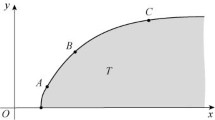Abstract
Sensitivity of the returns to scale (RTS) classifications in data envelopment analysis is studied by means of linear programming problems. The stability region for an observation preserving its current RTS classification (constant, increasing or decreasing returns to scale) can be easily investigated by the optimal values to a set of particular DEA-type formulations. Necessary and sufficient conditions are determined for preserving the RTS classifications when input or output data perturbations are non-proportional. It is shown that the sensitivity analysis method under proportional data perturbations can also be used to estimate the RTS classifications and discover the identical RTS regions yielded by the input-based and the output-based DEA methods. Thus, our approach provides information on both the RTS classifications and the stability of the classifications. This sensitivity analysis method can easily be applied via existing DEA codes.
Similar content being viewed by others
References
Banker, R. D. (1984). “Estimating Most Productive Scale Size Using Data Envelopment Analysis,” European Journal of Operational Research 17, 35–44.
Banker, R. D., A. Charnes, and W. W. Cooper. (1984). “Some Models for the Estimation of Technical and Scale Inefficiencies in Data Envelopment Analysis,” Management Science 30, 1078–1092.
Banker R. D. and R. M. Thrall. (1992). “Estimation of Returns to Scale Using Data Envelopment Analysis,” European Journal of Operational Research 62, 74–84.
Charnes, A., W. W. Cooper, and E. Rhodes. (1978). “Measuring the Efficiency of Decision Making Units,” European Journal of Operational Research 2, 429–441.
Charnes, A., W. W. Cooper, and S. Li. (1989). “Using DEA to Evaluate Relative Efficiencies in the Economic Performance of Chinese Key Cities,” Socio-Economic Planning Sciences 23, 325–344.
Charnes, A., W.W. Cooper, and R. M. Thrall. (1991). “A Structure for Classifying and Characterizing Efficiency and Inefficiency in Data Envelopment Analysis,” Journal of Productivity Analysis 2, 197–237.
Charnes, A., W. W. Cooper, A. Lewin, and L. M. Seiford. (1994). Data Envelopment Analysis: Theory, Methodology and Applications. Boston: Kluwer Academic Publishers.
Charnes, A. and L. Neralic. (1990). “Sensitivity Analysis of the Additive Model in Data Envelopment Analysis,” European Journal of Operational Research 48, 332–341.
Färe, R., S. Grosskopf, and C. A. K. Lovell. (1985). The Measurement of Efficiency of Production. Boston: Kluwer Nijhoff.
Färe, R., S. Grosskopf, and C. A. K. Lovell. (1994). Production Frontiers. Cambridge University Press.
Golany, B. and G. Yu. (1997). “Estimating Returns to Scale in DEA,” European Journal of Operational Research 103, 28–37.
Lewin, A. and L. M. Seiford. (1997). “Extending the Frontiers of DEA,” Annals of Operations Research 73, 1–11.
Seiford, Lawrence M. (1994). “A DEA Bibliography.” In Charnes, Cooper, Lewin, and Seiford (eds.), Data Envelopment Analysis: Theory, Methodology and Applications. Boston: Kluwer Academic Publishers.
Seiford, Lawrence M. (1996). “Data Envelopment Analysis: The Evolution of the State of the Art (1978–1995),” Journal of Productivity Analysis 7, 99–137.
Seiford, Lawrence M. (1997). “A Bibliography for Data Envelopment Analysis,” Annals of Operations Research 73, 393–438.
Seiford, Lawrence M. and R. M. Thrall. (1990). “Recent Developments in DEA: The Mathematical Programming Approach to Frontier Analysis,” Journal of Economics 46, 7–38.
Seiford, Lawrence M. and Joe Zhu. (1999). “An Investigation of Returns to Scale in Data Envelopment Analysis,” OMEGA. (to appear).
Seiford, Lawrence M. and Joe Zhu. (1998a). “Sensibility Analysis of DEA Models for Simultaneous Changes in all the Data,” Journal of the Operational Research Society 49, 1060–1071.
Seiford, Lawrence M. and Joe Zhu. (1998b). “Stability Regions for Maintaining Efficiency in Data Envelopment Analysis,” European Journal of Operational Research 108, 127–139.
Tone, K. (1996). “A Simple Characterization of Returns to Scale in DEA,” Journal of the Operations Research Society of Japan 39, 604–613.
Thrall, R. M. (1996). “Duality, Classification and Slacks in DEA,” Annals of Operations Research 66, 109–138.
Zhu, Joe and Z. Shen. (1995). “A Discussion of Testing DMUs' Returns to Scale,” European Journal of Operational Research 81, 590–596.
Zhu, Joe. (1996). “Robustness of the Efficient DMUs in Data Envelopment Analysis.” European Journal of Operational Research 90, 451–460.
Author information
Authors and Affiliations
Rights and permissions
About this article
Cite this article
Seiford, L.M., Zhu, J. Sensitivity and Stability of the Classifications of Returns to Scale in Data Envelopment Analysis. Journal of Productivity Analysis 12, 55–75 (1999). https://doi.org/10.1023/A:1007803207538
Issue Date:
DOI: https://doi.org/10.1023/A:1007803207538




